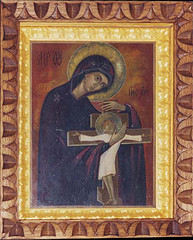The Trash Can Rescue was the code name for an undercover operation aimed at smuggling out Jewish children headed for the death camps in Paris. “The story occurs after Mother Maria had established the house with the blessing and help of her bishop, Metropolitan Evlogy Georgievsky, on rue de Lourmel. Word got out that something was happening at the stadium, not far from the house. “. . .There was a mass arrest of Jews — 12,884, of whom 6,900 (two-thirds of them children) were brought to the Velodrome d’Hiver . . . Held there for five days, the captives in the stadium received water only from a single hydrant, while ten latrines were supposed to serve them all. From there the captives were to be sent via Drancy to Auschwitz.”

Mother Maria of Paris wrote both poetry and religious essays in addition to running a soup kitchen and community center in a ghetto of Paris.
Because Mother Maria was well-known to the police and sanitation crews as she would scour the back alleys of Paris and the central market gathering day old food and recyclables for the poor of her community, she was granted access into the stadium. She quickly sized up the situation. The stadium had become a central transfer and processing hub for the thousands of Jews of Paris.
She prayed for assistance. The idea came to her. By employing the confidence of the local sanitation workers in charge of hauling the garbage from the stadium, Mother Maria perpetrated a plot that would at least save the children from the gas chambers: stuff them into the garbage bins, haul them out on the trucks from the stadium, and then under the cover of night, sneak the children to the house on rue de Lourmel where she then could orchestrate their continued passage to the south of France, an area outside of Nazi control, and to safety. The chronicle of the Trash Can Rescue has been memorialised in the children’s book Silent as Stone written by Jim Forest and beautifully illustrated by Dasha Pancheshnaya (St Vladimir’s Press: http://www.svspress.com/silent-as-a-stone/ )“It would have been possible for her to leave Paris when the Germans were advancing toward the city, or even to leave the country to go to America. Her decision was not to budge. “If the Germans take Paris, I shall stay here with my old women. Where else could I send them?” http://incommunion.org/2004/10/18/saint-of-the-open-door
No one is sure how many children Mother Maria and her garbage crew saved. But what is certain is that she eventually was found out by the Nazis. (When Nazis interrogated her about whether she had seen any Jews, she would point to an icon of the Mother of God or else point to the body of Christ on her crucifix.) The priest, Father Dimitri Klepinin who had served alongside her in the “monasticism in the world” and her son Yuri were arrested. They had been guilty of forging fake baptismal certificates for Jews who came begging for help. Yuri and Father Dimitri eventually died in Buchenwald camp while Mother Maria was sent to Ravensbruck. … It was Good Friday, March 30th, on the eve of the liberation of Paris, 1945, that Mother Maria was one of those chosen for death. According to other accounts, she took the place of another prisoner who was marked for the gas chamber that day. …
For the rest of the article go to http://greekamericangirl.com/mother-maria-of-paris-says-oxi-to-the-nazi-mass-murder-machine/
For more information about Maria’s activism, inspiration, grace, heroism, and hope-filled commitment, so needed in our world today, go to my earlier posts “Like a Russian Novel” at https://orthodoxcityhermit.com/2015/09/23/mother-maria-of-paris-saint-of-the-open-door/ and “Solitary and Naked Before God” at https://orthodoxcityhermit.com/2015/09/23/taking-up-the-cross/

























